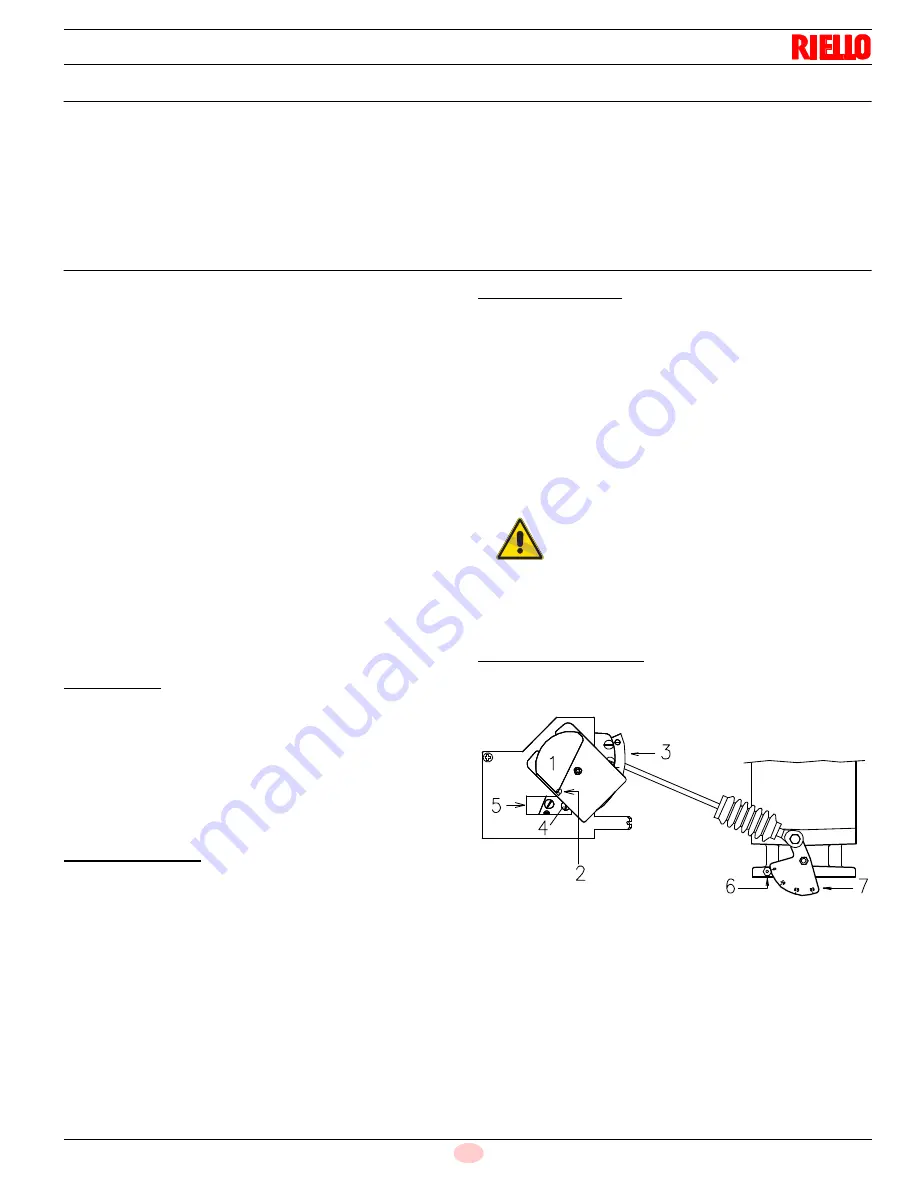
Start-up, calibration and operation of the burner
23
20040407
GB
5.4
Burner firing
Having completed the checks indicated in the previous heading,
the pilot of the burner should fire.
If the motor starts but the flame does not appear and the flame
safeguard goes into lock-out, reset and wait for a new firing at-
tempt.
Pilot adjustment has been illustrated on page 13.
Having adjusted the pilot, reconnect the main valve and ignite the
main flame; it might require several attempts to purge the air from
the gas lines or to adjust the valve with little gas.
Once the burner has fired, now proceed with calibration operations.
5.5
Burner calibration
The optimum calibration of the burner requires an analysis of the
flue gases at the boiler outlet.
Adjust successively:
➤
Firing output
➤
Maximum burner output
➤
Minimum burner output
➤
Intermediate outputs between low and high fire
➤
Air pressure switch
➤
Minimum gas pressure switch
5.5.1
Firing output
Pilot adjustment has been illustrated on page 13.
5.5.2
Maximum burner output
Maximum output of the burner must be set within the “Firing rate”
range shown at page 8. In the above instructions we left the burner
running in MIN. output operation.
➤
Move the selector 24)(Fig. 6) in manual position.
➤
Move the selector 43)(Fig. 6) in position (+) (increase output)
and keep it until the servomotor has opened the air damper
and the gas butterfly valve to 90°.
Gas calibration
Measure the gas delivery at the meter.
A guideline indication can be calculated from the Tab. H, page 17,
simply read off the gas pressure on the U-type manometer
(Fig. 25), and follow the instructions at page 17.
➤
If delivery needs to be reduced, reduce outlet gas pressure
and, if it is already very low, slightly close adjustment valve.
➤
If delivery needs to be increased, increase outlet gas pres-
sure.
Adjusting air delivery
Progressively adjust the end profile of cam 4)(Fig. 27) by turning
the cam adjustment screws as they appear through the access
opening 6).
➤
Turn the screws clockwise to increase air delivery.
➤
Turn the screws counter-clockwise to reduce air delivery.
5.5.3
Minimum burner output
Minimum output must be selected within the “Firing rate” range
shown at page 8.
➤
Move the selector 24)(Fig. 6) in manual position.
➤
Move the selector 43)(Fig. 6) in position (-) (reduction output)
until the servomotor has closed the air damper and the gas
butterfly valve to 15° (factory set adjustment).
Adjusting gas delivery
Measure the delivery of gas from the gas meter.
➤
If this value is to be reduced, decrease the angle of orange
cam slightly by proceeding a little at a time until the angle is
changed from 15° to 13° or 11°....
➤
Move the selector 24)(Fig. 6) in manual position.
➤
If it has to be increased move the selector 43)(Fig. 6) in posi-
tion (+) (increase output) (i.e. open the gas butterfly valve by
10-15°), increase the orange cam angle with small successive
movements, i.e. take it from angle 15° to 17° - 19°....
➤
Move the selector 43)(Fig. 6) in position (-) (reduction output)
until the servomotor is taken to the minimum opening position
and measure the gas delivery.
Adjustment of air delivery
Progressively adjust the starting profile of cam 4)(Fig. 27) by turn-
ing the screws working throught the access hole 6).
Key (Fig. 27)
1
Servomotor
2
Lever, push to engage, push to release
3
Adjustable profile cam
4
Cam profile adjustment screws
5
Opening for access to screws 5
6
Index for graduated sector 8
7
Graduated sector for gas butterfly valve
WARNING
The servomotor follows the adjustment of cam only
when the cam angle is reduced.
If it is necessary to increase the cam angle, first in-
crease the servomotor angle with the switch “output
increase”, then increase the orange cam angle, and
at the end bring the servomotor back to the MIN out-
put position with the switch ”output decrease”.
Fig. 27
D2267









































